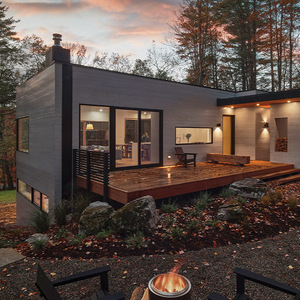Can the wiring to a water heater be extended via a junction box? It needs another 2-3 at least.
The existing wiring to a proposed new water heater will come up about 2-3 feet short. The way it’s currently run it offers zero slackage to work with. There is no easy shorter route to rerun the existing wiring to get any additional length.
Can some sort of junction box be installed in order to gain the required length that will be needed? This is in an unfinished basement area of the house. The basement is tight and always dry.
The wiring curently runs about 15 feet from the main panel to the existing water heater. I figure about 3 more feet might be required to reach the shorter WH we are thinking about. It would not be very easy to run new wiring from the main box to the new water heater.
The existing wiring is “Uniflex Type NM 12/2 WG (UL) 600V”. There are 2-20 Amp breakers involved.
Thanks



















Replies
That's what junction boxes are made for.
I can't think of any problem using a junction box. Use cable that is suitable for exposed use to connect to water heater, such as BX. You need to check to see what meets code in your area.
Don't install a "junction
Don't install a "junction box", install a "disconnect". Supposedly required for new construction in some area.
I don't see any reason why you couldn't utilize a junction box to extend your feed. A disconnect could function as a junction, but IMO adds unneccesary additional cost. Remember that any junction box must always remain accessible.
Thanks.
The existing WH is rated 4500 watts max, upper and lower elements, 240 Volts
The newer one we are thinking of is also 4500 watts max, dual element, 240 volts.
The current WH is probably the 4th one in the house. I think the cable's length is now so short due to it being cut and re-stripped for each successive WH.
This must be a problem that happens quite a bit, although I haven't found much info on it so far.
We replaced our water heater last winter, after 38 years. It hadn't failed but I figured it's days were numbered. Fed filtered soft water an electric heater should last a long time.
That really should be on a 30a circuit. I am surprised you don't get nuisanse trips of that 20a breaker.
I second the idea of using a disconnect for your "junction box".
Interesting.
From what I'm seeing this wiring should be upgraded. To 30 amp breakers.
Will this be a big deal for the installer? Will the cable also need to be upgraded?
I'm just trying to anticipate deviations from a standard install that will be costing more.
Thanks.
seemingly contridicting yourself fassbinder
What's your definition of a"big deal"? You've already stated that it was not going to be easy to run a new feed from the panel.
If you are using a 30a breaker, you need 10 gauge wire in this application.
conflicting rationals
Again, the manufacturer will outline the service requirements. I don't see why they would feel a need to recommend oversizing the service for any reason--general or not. Anyhow, if this is your reasoning for not having to re-pull 10 guage wire (which I agree with), then what is your rational for recommending a disconnect rather than a simple junction box? I don't believe it is code required to install a disconnect box for a water heater. While it would serve the same function as a junction box, it would be more expensive and seemingly represent an "oversized" response to the original posters question.
The reason is the electric code
The installation instructions require a 30a circuit 110.3(B)
This would be considered a continuous load since it takes more than 3 hours to heat a cold tank. 422.13
The code requires the circuit conductors shall be sized to 125% of the load 210.19(A)(1)
The overcurrent device must be 125% of load 210.20(A)
code?
gfretwell wrote:
The reason is the electric code
The installation instructions require a 30a circuit 110.3(B)
This would be considered a continuous load since it takes more than 3 hours to heat a cold tank. 422.13
The code requires the circuit conductors shall be sized to 125% of the load 210.19(A)(1)
The overcurrent device must be 125% of load 210.20(A)
Greg,
What installations instructions are you referring to? I don't see where the O.P. has even posted the name of the manufacturer of the water heater he is intending to use. If he hasn't, then apparently you think the electrical code is an installation manual...and I'm not seeing that . You're going to have to help me out with that linking those two together as a valid explanation.
Further, my understanding (as a G.C.) of an overcurrent device includes that of a panel circuit breaker. This is what I see as part of normal feed for a water heater--all achieved without the assistance of a switched (or fusably switched) disconnect. So again, my question is: What is your rational (in this case) for recommending a disconnect for a water heater feed? I don't see that referred to in your citation(s) of the electrical code.
The disconmnerct is required in 422.31(B)
[quote](B) Appliances Rated over 300 Volt-Amperes or 1/8 Horsepower. For permanently connected appliances rated over 300 volt-amperes or 1/8 hp, the branch-circuit switch or circuit breaker shall be permitted to serve as the disconnecting means where the switch or circuit breaker is within sight from the appliance or is capable of being locked in the open position. The provision for locking or adding a lock to the disconnecting means shall be installed on or at the switch or circuit breaker used as the disconnecting means and shall remain in place with or without the lock installed.
110.3(B) says
[quote](B) Installation and Use. Listed or labeled equipment shall be installed and used in accordance with any instructions included in the listing or labeling.
Find me a 4500w water heater that says it can be installed on a 20a circuit and I will admit I am wrong.
You just shot your own argument down
I never questioned the assertion that the water heater in question required a 30 amp breaker and associated 10 guage wire. I merely questioned why you (or Dan) would recommend the use of a disconnect rather than a regular junction box to extend the feed. Your rational was that a disconnect was required by code. The exception you cite in 422.31(B) clearly states when a disconnect is not required by code. Further, The latest info provided by O.P. confirms that exception and alleviates, in this case, the need for a code required disconnect.
In the end (and as I stated eariler) the original question of whether an existing feed wire can be junctioned is a moot point. However, IMO, misrepresenting code compliance never is.
Yes, itr is clearly not required if the breaker is "within sight" or capable of being locked open. Do you really think he has a lockout kit on a residential breaker panel?
It is unlikely that the panel is within sight or it would not be hard to put in the 30a circuit he needs,
Personally I do not care anymore. If you want to hook your water heater with zip lead and shove the stripped ends into the dryer outlet it is OK by me. The smoke won't get to my house and I won't hear the sirens..
No need for that
Greg,
No need to be a poor sport... or assume anyone is a liar. Bottom line is that this forum is a learning experience for everyone. I still have alot of respect for your insight and knowledge.
BTW, your electrical code citation reads: "...is within sight from the appliance or is capable of being locked in the open position." To me, that reads as an either/or propostion, not an additonal code requirement. Just sayin.
You are right but you have to do one OR the other.
If the breaker is not within sight, the breaker has to have a lockout kit installed.
Most people have never even seen a lockout kit for a residential panel. If you found one it would cost more than a 30a pull out disconnect. You could even use a 30a 2 pole snap switch in a 1900 box with a raised switch cover. (less than $10 for the whole thing including the box and cover he needs anyway).
great idea
If the OP's panel is not in sight, then your snap switch in a 1900 box (to remain accessible) sounds like a great, cost effective alternative. This kind of professional insight is why I always look forward to your responses.
I got quite a bit of info over the past couple days from various sources.
The water heater will be 4500 watts continuous. It will require a 30 amp double pole upgraded breaker (from it's current 20 amp double pole breaker).
The cable will also have to be upgraded to 10 gauge. Since the cable will need to be replaced there will be no need for either a junction box or a disconnect. From what I've read, a disconnect would not be required as the water heater is within sight of the breaker (5 feet away).
Thanks for the help and feedback.
I got quite a bit of info over the past couple days from various sources.
The water heater will be 4500 watts continuous. It will require a 30 amp double pole upgraded breaker (from it's current 20 amp double pole breaker).
The cable will also have to be upgraded to 10 gauge. Since the cable will need to be replaced there will be no need for either a junction box or a disconnect. From what I've read, a disconnect would not be required as the water heater is within sight of the breaker (5 feet away).
Thanks for the help and feedback.
Balancing the panel's legs after upgrading from 20 to 30 amp?
The water heater is currently served by a 20a dual post breaker located on the left side of the box. When this is upgraded to 30a will balancing need to be done between the right and left legs?
There are a few circuits on both sides of the panel serving various baseboard heating units which are no longer used. There is also a 20a circuit serving a dishwasher which was never installed.
Both the left and right sides of the panel have one 15a and 1 20a breaker that is no longer needed.
Left Side Right Side
30a (new water heater, was 20a)
20a uninstalled dishwasher 20a unused bsbrd heater
15a unused baseboard heater 15a unused bsbrd heater
"Modern" 240V breaker panels
"Modern" 240V breaker panels (ie, those made in the past 50 years or so) are arranged so that alternating breaker slots are on opposite sides of the 240V line. When you install a double breaker it automatically goes on both legs and things are automatically "balanced". (If the breaker didn't hit both legs there would be no voltage at all fed to the water heater.)
Any suggestions on how this new cable should run from WH to Main
Attached is a photo showing the Main Box and the distance between it and
the Water Heater.
The current 12/2 cable runs out the top of the box, then turns left
and runs 4 feet between the floor joist and over the drywall ceiling,
then down through the plate and along the vertical framing.
The top of the new water heater will be 3 feet below the ceiling.
I'm wondering what options there might be for running the new 10/2
cable from the box to the water heater.
Thanks.
There are various interpretations of the code for this sort of thing, but the cable must be reasonably protected from damage and must not be so placed as it would be likely to be used, eg, to hang up clothes hangers as stuff is taken from the dryer. Fastening tightly to the ceiling on every joist would probably suffice, but some inspectors would demand (to some degree depending on the height of the ceiling, etc) that it be covered by, eg, a 1x2 or a "raceway" (Wiremold).
Are you, as the homeowner, planning to run this new feed and tie it into the panel? If not, then that is a question you should be asking the electrician you hire to do the job. I imagine he will have the experience and tools required to give you a satisfactory answer.
Conduit. You can keep it exposed on the ceiling, wall, where ever.